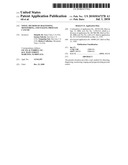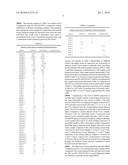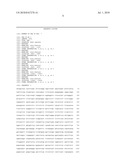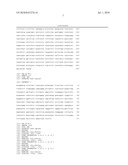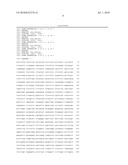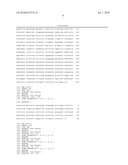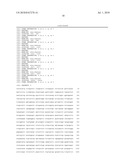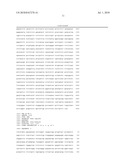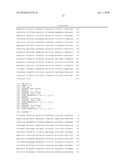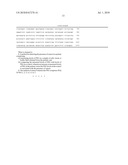Patent application title: Novel Method of Diagnosing, Monitoring, and Staging Prostate Cancer
Inventors:
Shujath Ali (Santa Clara, CA, US)
Susana Salceda (San Jose, CA, US)
Yongming Sun (San Jose, CA, US)
Robert Cafferkey (Mountain View, CA, US)
IPC8 Class: AC12Q168FI
USPC Class:
435 6
Class name: Chemistry: molecular biology and microbiology measuring or testing process involving enzymes or micro-organisms; composition or test strip therefore; processes of forming such composition or test strip involving nucleic acid
Publication date: 2010-07-01
Patent application number: 20100167278
Claims:
1. A method for detecting the presence of cancer in a patient
comprising:(a) measuring levels of PSG in a sample of cells, tissue or
bodily fluid obtained from the patient; and(b) comparing the measured
levels of PSG with levels of PSG in a control, wherein an increase in
measured levels of PSG in the patient versus the PSG levels in the
control is associated with the presence of cancer.
2. The method of claim 1 wherein the PSG comprises SEQ ID NO:1, 2, 3, 4, 5, 6 or 7.
Description:
[0001]This patent application is a continuation of U.S. application Ser.
No. 10/939,560, filed Sep. 14, 2004, which is a divisional application of
U.S. application Ser. No. 09/700,700, filed Nov. 20, 2000, issued as U.S.
Pat. No. 6,861,215, which is the U.S. National phase of
PCT/US1999/010548, filed May 12, 1999, which claims the benefit of
priority from U.S. Provisional Application Ser. No. 60/086,265, filed May
21, 1998, teachings of each of which are herein incorporated by reference
in their entireties.
FIELD OF THE INVENTION
[0002]This invention relates, in part, to newly developed assays for detecting, diagnosing, monitoring, staging, and prognosticating cancers, particularly prostate cancer.
BACKGROUND OF THE INVENTION
[0003]Cancer of the prostate is the most prevalent malignancy in adult males, excluding skin cancer, and is an increasingly prevalent health problem in the United States. In 1996, it was estimated that in the United States, 41,400 deaths would result from this disease, indicating that prostate cancer is second only to lung cancer as the most common cause of death in the same population. If diagnosed and treated early, when the cancer is still confined to the prostate, the chance of cure is significantly higher.
[0004]Treatment decisions for an individual are linked to the stage of prostate cancer present in that individual. A common classification of the spread of prostate cancer was developed by the American Urological Association (AUA). The AUA classification divides prostate tumors into four stages, A to D. Stage A, microscopic cancer within prostate, is further subdivided into stages A1 and A2. Sub-stage A1 is a well-differentiated cancer confined to one site within the prostate. Treatment is generally observation, radical prostatectomy, or radiation. Sub-stage A2 is a moderately to poorly differentiated cancer at multiple sites within the prostate. Treatment is radical prostatectomy or radiation. Stage B, palpable lump within the prostate, is further subdivided into stages B1 and B2. In sub-stage B1, the cancer forms a small nodule in one lobe of the prostate. In sub-stage B2, the cancer forms large or multiple nodules, or occurs in both lobes of the prostate. Treatment for both sub-stages B1 and B2 is either radical prostatectomy or radiation. Stage C is a large cancer mass involving most or all of the prostate and is further subdivided into two stages. In sub-stage C1, the cancer forms a continuous mass that may have extended beyond the prostate. In sub-stage C2, the cancer forms a continuous mass that invades the surrounding tissue. Treatment for both these sub-stages is radiation with or without drugs. The fourth stage is metastatic cancer and is also subdivided into two stages. In sub-stage D1, the cancer appears in the lymph nodes of the pelvis. In sub-stage D2, the cancer involves tissues beyond lymph nodes. Treatment for both these sub-stages is systemic drugs to address the cancer as well as pain.
[0005]However, current prostate cancer staging methods are limited. As many as 50% of prostate cancers initially staged as A2, B, or C are actually stage D, metastatic. Discovery of metastasis is significant because patients with metastatic cancers have a poorer prognosis and require significantly different therapy than those with localized cancers. The five year survival rates for patients with localized and metastatic prostate cancers are 93% and 29%, respectively.
[0006]Accordingly, there is a great need for increasingly sensitive methods for the staging of a cancer in a human to determine whether or not such cancer has metastasized and for monitoring the progress of a cancer in a human.
[0007]In the present invention, methods are provided for detecting, diagnosing, monitoring, staging and prognosticating cancers, particularly prostate cancer via seven (7) Prostate Specific Genes (PSG). The seven PSGs refer, among other things, to native proteins expressed by the genes comprising the polynucleotide sequences of any of SEQ ID NO: 1, 2, 3, 4, 5, 6 or 7. In the alternative, what is meant by the seven PSGs as used herein, means the native mRNAs encoded by the genes comprising any of the polynucleotide sequences of SEQ ID NO: 1, 2, 3, 4, 5, 6 or 7 or levels of the genes comprising any of the polynucleotide sequences of SEQ ID NO: 1, 2, 3, 4, 5, 6 or 7.
[0008]Other objects, features, advantages and aspects of the present invention will become apparent to those of skill in the art from the following description. It should be understood, however, that the following description and the specific examples, while indicating preferred embodiments of the invention, are given by way of illustration only. Various changes and modifications within the spirit and scope of the disclosed invention will become readily apparent to those skilled in the art from reading the following description and from reading the other parts of the present disclosure.
SUMMARY OF THE INVENTION
[0009]Toward these ends, and others, it is an object of the present invention to provide a method for diagnosing the presence of prostate cancer in a patient which comprises measuring levels of PSG in a sample of cells, tissue or bodily fluid from the patient and comparing the measured levels of PSG with levels of PSG in preferably the same cells, tissue, or bodily fluid type of a control, wherein an increase in the measured PSG levels in the patient versus levels of PSG in the control is associated with prostate cancer.
[0010]Another object of the present invention is to provide a method of diagnosing metastatic prostate cancer in a patient which comprises measuring PSG levels in a sample of cells, tissue, or bodily fluid from the patient and comparing the measured PSG levels with levels of PSG in preferably the same cells, tissue, or bodily fluid type of a control, wherein an increase in measured PSG levels in the patient versus levels of PSG in the control is associated with a cancer which has metastasized.
[0011]Another object of the present invention is to provide a method of staging prostate cancer in a patient which comprises identifying a patient having prostate cancer, measuring levels of PSG in a sample of cells, tissues, or bodily fluid obtained from the patient, and comparing the measured PSG levels with levels of PSG in preferably the same cells, tissue or bodily fluid type of a control. An increase in measured PSG levels in the patient versus PSG levels in the control can be associated with a cancer which is progressing while a decrease or equivalent level of PSG measured in the patient versus the control can be associated with a cancer which is regressing or in remission.
[0012]Another object of the present invention is to provide a method of monitoring prostate cancer in a patient for the onset of metastasis. The method comprises identifying a patient having prostate cancer that is not known to have metastasized, periodically measuring levels of PSG in a sample of cells, tissues, or bodily fluid obtained from the patient, and comparing the measured PSG levels with levels of PSG in preferably the same cells, tissue, or bodily fluid type of a control, wherein an increase in measured PSG levels versus control PSG levels is associated with a cancer which has metastasized.
[0013]Yet another object of the present invention is to provide a method of monitoring the change in stage of prostate cancer in a patient which comprises identifying a patient having prostate cancer, periodically measuring levels of PSG in a sample of cells, tissue, or bodily fluid obtained from the patient, and comparing the measured PSG levels with levels of PSG in preferably the same cells, tissues, or bodily fluid type of a control wherein an increase in measured PSG levels versus the control PSG levels is associated with a cancer which is progressing and a decrease in the measured PSG levels versus the control PSG levels is associated with a cancer which is regressing or in remission.
[0014]Other objects, features, advantages and aspects of the present invention will become apparent to those of skill in the art from the following description. It should be understood, however, that the following description and the specific examples, while indicating preferred embodiments of the invention, are given by way of illustration only. Various changes and modifications within the spirit and scope of the disclosed invention will become readily apparent to those skilled in the art from reading the following description and from reading the other parts of the present disclosure.
DESCRIPTION OF THE INVENTION
[0015]The present invention relates to diagnostic assays and methods, both quantitative and qualitative for detecting, diagnosing, monitoring, staging, and prognosticating cancers by comparing levels of PSG measured in a patient with levels of PSG in a control. What is meant by "levels of PSG" as used herein, means levels of the native protein expressed by the gene comprising the polynucleotide sequence of any of SEQ ID NO: 1, 2, 3, 4, 5, 6 or 7. In the alternative, what is meant by "levels of PSG" as used herein, is levels of the native mRNA encoded by the gene comprising any of the polynucleotide sequence of SEQ ID NO: 1, 2, 3, 4, 5, 6 or 7 or levels of the gene comprising any of the polynucleotide sequence of SEQ ID NO: 1, 2, 3, 4, 5, 6 or 7. Such levels are preferably measured in at least one of cells, tissues and/or bodily fluids, and includes determination of both normal and abnormal levels of PSGs. Thus, for instance, a diagnostic assay in accordance with the invention for diagnosing overexpression of PSG protein compared to control bodily fluids, cells, or tissue samples may be used to diagnose the presence of cancers, including prostate cancer. Any of the seven PSGs may be measured alone in the methods of the invention, all together or in various combinations of the seven PSGs.
[0016]By "control" it is meant a human patient without cancer and/or non cancerous samples from the patient, also referred to herein as a normal human control; in the methods for diagnosing or monitoring for metastasis, control may also include samples from a human patient that is determined by reliable methods to have prostate cancer which has not metastasized.
[0017]All the methods of the present invention may optionally include measuring the levels of other cancer markers as well as PSG. Other cancer markers, in addition to PSG, useful in the present invention will depend on the cancer being tested and are known to those of skill in the art. For example, simultaneous testing for increases in PSA as well as increases in PSG are also within the scope of the present invention and believed to provide a higher level of assurance that such cancer being tested is metastatic or the onset of metastasis has occurred.
Diagnostic Assays
[0018]The present invention provides methods for diagnosing the presence of prostate cancer by analyzing for changes in levels of PSG in cells, tissues or bodily fluids compared with levels of PSG in cells, tissues or bodily fluids of preferably the same type from a normal human control, wherein an increase in levels of PSG in the patient versus the normal human control is associated with the presence of prostate cancer. Without limiting the instant invention, typically, for a quantitative diagnostic assay a positive result indicating the patient being tested has cancer is one in which cells, tissues, or bodily fluid levels of the cancer marker, such as PSG, are at least two times higher, and most preferably are at least five times higher, than in preferably the same cells, tissues, or bodily fluid of a normal human control.
[0019]The present invention also provides a method of diagnosing metastatic prostate cancer in a patient having prostate cancer which has not yet metastasized for the onset of metastasis. In the method of the present invention, a human cancer patient suspected of having prostate cancer which may have metastasized (but which was not previously known to have metastasized) is identified. This is accomplished by a variety of means known to those of skill in the art. For example, in the case of prostate cancer, patients are typically diagnosed with prostate cancer following traditional detection methods.
[0020]In the present invention, determining the presence of PSG in cells, tissues, or bodily fluid, is particularly useful for discriminating between prostate cancer which has not metastasized and prostate cancer which has metastasized.
[0021]Existing techniques have difficulty discriminating between prostate cancer which has metastasized and prostate cancer which has not metastasized and proper treatment selection is often dependent upon such knowledge.
[0022]In the present invention, the cancer marker levels measured in such cells, tissue, or bodily fluid are PSGs, and are compared with levels of PSG in preferably the same cells, tissue, or bodily fluid type of a normal human control. That is, if the cancer marker being observed is just PSG in serum, this level is preferably compared with the level of PSG in serum of a normal human patient. An increase in the PSG in the patient versus the normal human control is associated with prostate cancer which has metastasized.
[0023]Without limiting the instant invention, typically, for a quantitative diagnostic assay a positive result indicating the cancer in the patient being tested or monitored has metastasized is one in which cells, tissues, or bodily fluid levels of the cancer marker, such as PSG, are at least two times higher, and most preferable are at least five times higher, than in preferably the same cells, tissues, or bodily fluid of a normal patient.
Staging
[0024]The invention also provides a method of staging prostate cancer in a human patient.
[0025]The method comprises identifying a human patient having such cancer and analyzing a sample of cells, tissues, or bodily fluid from such patient for PSG. Then, the method compares PSG levels in such cells, tissues, or bodily fluid with levels of PSG in preferably the same cells, tissues, or bodily fluid type of a normal human control sample, wherein an increase in PSG levels in the patient versus the normal human control is associated with a cancer which is progressing and a decrease in the levels of PSG is associated with a cancer which is regressing or in remission.
Monitoring
[0026]Further provided is a method of monitoring prostate cancer in a human having such cancer for the onset of metastasis. The method comprises identifying a human patient having such cancer that is not known to have metastasized; periodically analyzing a sample of cells, tissues, or bodily fluid from such patient for PSG; and comparing the PSG levels in such cells, tissue, or bodily fluid with levels of PSG in preferably the same cells, tissues, or bodily fluid type of a normal human control sample, wherein an increase in PSG levels in the patient versus the normal human control is associated with a cancer which has metastasized.
[0027]Further provided by this invention is a method of monitoring the change in stage of prostate cancer in a human having such cancer. The method comprises identifying a human patient having such cancer; periodically analyzing a sample of cells, tissue, or bodily fluid from such patient for PSG; comparing the PSG levels in such cells, tissue, or bodily fluid with levels of PSG in preferably the same patient.
[0028]Monitoring such patient for onset of metastasis is periodic and preferably done on a quarterly basis. However, this may be more or less frequent depending on the cancer, the particular patient, and the stage of the cancer.
Assay Techniques
[0029]Assay techniques that can be used to determine levels of gene expression, such as PSG of the present invention, in a sample derived from a host are well-known to those of skill in the art. Such assay methods include radioimmunoassays, reverse transcriptase PCR (RT-PCR) assays, immunohistochemistry assays, in situ hybridization assays, competitive-binding assays, Western Blot analyses and ELISA assays. Among these, ELISAs are frequently preferred to diagnose a gene's expressed protein in biological fluids. An ELISA assay initially comprises preparing an antibody, if not readily available from a commercial source, specific to PSG, preferably a monoclonal antibody. In addition a reporter antibody generally is prepared which binds specifically to PSG. The reporter antibody is attached to a detectable reagent such as radioactive, fluorescent or enzymatic reagent, for example horseradish peroxidase enzyme or alkaline phosphatase.
[0030]To carry out the ELISA, antibody specific to PSG is incubated on a solid support, e.g., a polystyrene dish, that binds the antibody. Any free protein binding sites on the dish are then covered by incubating with a non-specific protein such as bovine serum albumin. Next, the sample to be analyzed is incubated in the dish, during which time PSG binds to the specific antibody attached to the polystyrene dish. Unbound sample is washed out with buffer. A reporter antibody specifically directed to PSG and linked to horseradish peroxidase is placed in the dish resulting in binding of the reporter antibody to any monoclonal antibody bound to PSG. Unattached reporter antibody is then washed out. Reagents for peroxidase activity, including a colorimetric substrate are then added to the dish. Immobilized peroxidase, linked to PSG antibodies, produces a colored reaction product. The amount of color developed in a given time period is proportional to the amount of PSG protein present in the sample. Quantitative results typically are obtained by reference to a standard curve.
[0031]A competition assay may be employed wherein antibodies specific to PSG attached to a solid support and labeled PSG and a sample derived from the host are passed over the solid support and the amount of label detected attached to the solid support can be correlated to a quantity of PSG in the sample.
[0032]Nucleic acid methods may be used to detect PSG mRNA as a marker for prostate cancer. Polymerase chain reaction (PCR) and other nucleic acid methods, such as ligase chain reaction (LCR) and nucleic acid sequence based amplification (NASABA), can be used to detect malignant cells for diagnosis and monitoring of various malignancies. For example, reverse-transcriptase PCR (RT-PCR) is a powerful technique which can be used to detect the presence of a specific mRNA population in a complex mixture of thousands of other mRNA species. In RT-PCR, an mRNA species is first reverse transcribed to complementary DNA (cDNA) with use of the enzyme reverse transcriptase; the cDNA is then amplified as in a standard PCR reaction. RT-PCR can thus reveal by amplification the presence of a single species of mRNA. Accordingly, if the mRNA is highly specific for the cell that produces it, RT-PCR can be used to identify the presence of a specific type of cell.
[0033]Hybridization to clones or oligonucleotides arrayed on a solid support (i.e., gridding) can be used to both detect the expression of and quantitate the level of expression of that gene. In this approach, a cDNA encoding the PSG gene is fixed to a substrate. The substrate may be of any suitable type including but not limited to glass, nitrocellulose, nylon or plastic. At least a portion of the DNA encoding the PSG gene is attached to the substrate and then incubated with the analyte, which may be RNA or a complementary DNA (cDNA) copy of the RNA, isolated from the tissue of interest.
[0034]Hybridization between the substrate bound DNA and the analyte can be detected and quantitated by several means including but not limited to radioactive labeling or fluorescence labeling of the analyte or a secondary molecule designed to detect the hybrid. Quantitation of the level of gene expression can be done by comparison of the intensity of the signal from the analyte compared with that determined from known standards. The standards can be obtained by in vitro transcription of the target gene, quantitating the yield, and then using that material to generate a standard curve.
[0035]The above tests can be carried out on samples derived from a variety of patients' cells, bodily fluids and/or tissue extracts (homogenates or solubilized tissue) such as from tissue biopsy and autopsy material. Bodily fluids useful in the present invention include blood, urine, saliva, or any other bodily secretion or derivative thereof. Blood can include whole blood, plasma, serum, or any derivative of blood.
Examples
[0036]The present invention is further described by the following examples. These examples are provided solely to illustrate the invention by reference to specific embodiments. These exemplifications, while illustrating certain specific aspects of the invention, do not portray the limitations or circumscribe the scope of the disclosed invention.
Example 1
PSGs
[0037]Searches were carried out and PSGs identified using the following Search Tools as part of the LIFESEQ® database available from Incyte Pharmaceuticals, Palo Alto, Calif.:
[0038]1. Library Comparison (compares one library to one other library) allows the identification of clones expressed in tumor and absent or expressed at a lower level in normal tissue.
[0039]2. Subsetting is similar to library comparison but allows the identification of clones expressed in a pool of libraries and absent or expressed at a lower level in a second pool of libraries.
[0040]3. Transcript Imaging lists all of the clones in a single library or a pool of libraries based on abundance. Individual clones can then be examined using Electronic Northerns to determine the tissue sources of their component ESTs.
[0041]4. Protein Function: Incyte has identified subsets of ESTs with a potential protein function based on homologies to known proteins. Some examples in this database include Transcription Factors and Proteases. Some leads were identified by searching in this database for clones whose component ESTs showed disease specificity.
[0042]Electronic subtractions, transcript imaging and protein function searches were used to identify clones, whose component ESTs were exclusively or more frequently found in libraries from specific tumors. Individual candidate clones were examined in detail by checking where each EST originated.
TABLE-US-00001 TABLE 1 SEQ ID NO: Clone ID # Gene ID # 1 1550426 244673 Protein Function (Transcription Factors) 2 1255804 14878 Subsetting 3 1808432 255819 Subsetting 4 3930803 none Subsetting 5 645804 235032 Subsetting 6 1862352 221558 Subsetting 7 1450626 236019 Subsetting
Example 2
Measurement of SEQ ID NO:1; Clone ID #1550426; Gene ID #244673 (pro101)
[0043]The example is carried out using standard techniques, which are well known and routine to those of skill in the art, except where otherwise described in detail. Routine molecular biology techniques of the following example are carried out as described in standard laboratory manuals, such as Sambrook et al., MOLECULAR CLONING: A LABORATORY MANUAL, 2nd Ed.; Cold Spring Harbor Laboratory Press, Cold Spring Harbor, N.Y. (1989).
Relative Quantitation of Gene Expression
[0044]Real-time quantitative PCR with fluorescent Taqman probes is a quantitative detection system utilizing the 5'-3' nuclease activity of Taq DNA polymerase. The method uses an internal fluorescent oligonucleotide probe (Taqman) labeled with a 5' reporter dye and a downstream, quencher dye. During PCR, the 5'-3' nuclease activity of Taq DNA polymerase releases the reporter, whose fluorescence can then be detected by the laser detector of the Model 7700 Sequence Detection System (PE Applied Biosystems, Foster City, Calif., USA).
[0045]Amplification of an endogenous control is used to standardize the amount of sample RNA added to the reaction and normalize for Reverse Transcriptase (RT) efficiency. Either cyclophilin, glyceraldehyde-3-phosphate dehydrogenase (GAPDH) or 18S ribosomal RNA (rRNA) is used as this endogenous control. To calculate relative quantitation between all the samples studied, the target RNA levels for one sample are used as the basis for comparative results (calibrator). Quantitation relative to the "calibrator" is obtained using the standard curve method or the comparative method (User Bulletin #2: ABI PRISM 7700 Sequence Detection System). To evaluate the tissue distribution, and the level of pro101 (SEQ ID NO:1) in normal and tumor tissue, total RNA was extracted from tumor and matched normal adjacent tissues and from unmatched tumor and normal tissues. Subsequently, first strand cDNA was prepared with reverse transcriptase and the polymerase chain reaction carried out using primers and Tagman probe specific to pro101 (SEQ ID NO:1). The results were obtained using the ABI PRISM 7700 Sequence Detector. The absolute numbers are relative levels of expression of pro101 (SEQ ID NO:1) compared to the calibrator. The absolute numbers are depicted in the following
[0046]Table 2 as relative levels of expression in 12 normal tissues of pro101 (SEQ ID NO:1) compared to kidney (calibrator). These RNA samples were generated by pooling samples from a particular tissue from different individuals.
TABLE-US-00002 TABLE 2 Relative levels of pro101 Expression in Pooled Samples Tissue NORMAL Brain 1.2 Heart 2 Kidney 1 Liver 7.2 Lung 48.2 Mammary 2.5 Prostate 1418.4 Spleen 1.6 Small 1.9 Testis 57.3 Thymus 1.3 Uterus 7.6
[0047]The relative levels of expression in Table 2 show that for the PSG pro101 (SEQ ID NO:1) mRNA expression is more than 20 fold higher in the pool of normal prostate compared with the other 11 normal tissue pools analyzed. These results demonstrate that mRNA expression of the PSG is highly specific for prostate.
[0048]The tissues shown in Table 2 correspond to pools of samples from different individuals. The tissues shown in the following Table 3 were obtained from individuals and are not pooled. Hence the values for mRNA expression levels shown in Table 2 cannot be directly compared to the values shown in Table 3.
[0049]The absolute numbers in Table 3 are relative levels of expression of pro101 (SEQ ID NO:1) compared to kidney (calibrator), in 60 pairs of matching samples. Each matching pair contains the cancer sample for a particular tissue and the normal adjacent sample for that same tissue from the same individual. The results from 3 unmatched ovary tumor, 3 unmatched normal ovary, 1 unmatched mammary tumor and 1 unmatched normal mammary gland are also shown.
TABLE-US-00003 TABLE 3 Relative Levels of pro101 Expression in Individual Samples TISSUE CANCER MATCHING UNMATCHED Prostate 1 103.9 0 Prostate 2 2219 84.2 Prostate 3 5048.2 3623.6 Prostate 4 11052.3 2029.4 Prostate 5 229.1 41.1 Prostate 6 57.9 25.3 Prostate 7 58.5 57.069 Prostate 8 1074.6 610.8 Prostate 9 32.7 79.3 Prostate 10 15.8 2.09 Prostate 11 436.4 438 Prostate 12 49.5 59.3 Prostate 13 128 56 Bladder 1 0 0 Bladder 2 0 0 Bladder 3 0.7 0 Colon 1 0 0 Colon 2 0 0 Colon 3 0 0 Colon 4 3.3 1.9 Colon 5 0.1 0.8 Colon 6 0 0 Lung 1 0 0 Lung 2 0.5 1.6 Lung 3 1.4 2.1 Lung 4 0 0 Lung 5 0 0 Kidney 1 0 0 Kidney 2 0 0 Kidney 3 0 0 Kidney 4 0 0 Liver 1 1.5 5.7 Liver 2 26.9 7.9 Liver 3 0 0 Pancreas 1 0.9 0.9 Pancreas 2 3 0 Pancreas 3 0 0 Pancreas 4 0 0 Pancreas 5 0 0 Stomach 1 0 0 Stomach 2 0 0 Stomach 3 0 0 Stomach 4 0 0 Stomach 5 0 0 Sm Int 1 0 0 Sm Int 2 0 0 Testis 1 0 0 Mammary 1 4 0 Mammary 2 5.6 0 Mammary 3 0.5 0 Mammary 4 0.4 0 Mammary 5 0.5 Mammary 6 0 Endo 1 1.6 7.6 Endo 2 0 0 Endo 3 0 0 Endo 4 0.3 0.2 Endo 5 5.8 5 Uterus 1 0 0 Uterus 2 0 0 Uterus 3 0 0 Uterus 4 2.2 2.6 Ovary 1 1.4 Ovary 2 11.6 Ovary 3 1.5 Ovary 4 22.9 Ovary 5 0 Ovary 6 1.8
Among 128 samples in Table 3 representing 14 different tissues, the higher levels of expression are consistently in prostate tissues. These results confirm the tissue specificity results obtained with normal samples shown in Table 2. Table 2 and Table 3 represent a combined total of 140 samples in 18 human tissue types. Sixty-eight samples representing 13 different tissue types excluding prostate had no detected pro101 mRNA (Table 3). In 4 tissues (stomach small intestine kidney and testis) no pro101 (SEQ ID NO:1) mRNA was detected for any sample tested from individuals (Table 3). Expression of this PSG was detected in testis in the pooled normal sample (Table 3). The median expression in prostate cancer samples in Table 3 is 166.5 units. Excluding Ovary 4 (Normal), only 1 sample in Table 3, Liver 2 (Cancer), is greater than 10% of this value.
[0050]Comparisons of the level of mRNA expression in prostate tumor samples and the normal adjacent tissue from the same individuals are also shown in Table 3. The PSG pro101 (SEQ ID NO:1) is expressed at higher levels in 9 of 13 (69%) prostate cancer tissues (Prostate 1, 2, 3, 4, 5, 6, 8, 10 and 13) compared with the corresponding normal adjacent tissue. The level of expression of this PSG is lower in prostate tumor compared to normal adjacent tissue in two samples (Prostate 9 and 12). Equivalent levels of expression were detected in two matched samples (Prostate 7 and 11). Previous mRNA expression analysis for genes coding for the diagnostic markers PSA and PLA2 showed higher expression of the mRNA in 40% to 80% of the tumor samples compared to matching normal adjacent tissue. Higher expression in the tumor sample compared to the corresponding normal adjacent tissue is observed for Bladder 3, Colon 4, Liver 2, Pancreas 2, Endometrium 5 and. Mammary 1, 2 and 3. Higher expression in the normal adjacent samples is observed for Colon 5, Lung 2, Lung 3, Liver 1, Endometrium 1 and Uterus 4. However, the levels detected are in most cases comparable amongst the different tissues and low compared to levels found in most prostate tissues.
[0051]The high level of tissue specificity, plus the mRNA overexpression in 9 of 13 of the prostate tumor samples tested compared to the normal adjacent tissues are believed to make the PSG, pro101 (SEQ ID NO:1) a good diagnostic marker for detection of prostate cancer using mRNA.
Sequence CWU
1
711936DNAHomo sapiensmisc_feature(106)..(106)n is a, c, g, or t
1aatggtatgc caacttaagt atttacaggg tggcccaaat agaacaagat gcactcgctg
60tgattttaag acaagctgta taaacagaac tccactgcaa gagggngggc cgggccagga
120gaatctccgc ttgtccaaga caggggccta aggagggtct ccacactgct gctaggggct
180gttgcatttt tttattagta gaaagtggaa aggcctcttc tcaacttttt tcccttgggc
240tggagaattt agaatcagaa gtttcctgga gttttcaggc tatcatatat actgtatcct
300gaaaggcaac ataattcttc cttccctcct tttaaaattt tgtgttcctt tttgcagcaa
360ttactcacta aagggcttca ttttagtcca gatttttagt ctggctgcac ctaacttatg
420cctcgcttat ttagcccgag atctggtctt ttttntgtnt tttttttntt tccgtctccc
480caaagcttta tctgtcttga ctttttaaaa aagtttgggg gcagattctg aattgggcta
540aaagacatgc atttttaaaa ctaggcaact tcttatttct ttcctttaaa aatacatagc
600attaaatccc aaatcctatt taaagacctg acagcttgag aaggtcacta ctgcatttat
660aggaccttct ggtggttctg ctgttacgtt tgaagtctga caatccttga gaatctttgc
720atgcagagga ggtaagaggt attggatttt cacagaggaa gaacacagcg cagaatgaag
780ggccaggctt actgaggctg tccagtggag ggctcatggg tgggacatgg aaaagaaggc
840agcctaggcc ctggggagcc cagtccactg agcaagcaag ggactgagtg agccttttgc
900aggaaaaggc taagaaaaag gaaaaccatt ctaaaacaca acaagaaact gtccaaatgc
960tttgggaact gtgtttattg cctataatgg gtccccaaaa tgggtaacct agacttcaga
1020gagaatgagc agagagcaaa ggagaaatct ggctgtcctt ccattttcat tctgttatct
1080caggtgagct ggtagagggg agacattaga aaaaaatgaa acaacaaaac aattactaat
1140gaggtacgct gaggcctggg agtctcttga ctccactact taattccgtt tagtgagaaa
1200cctttcaatt ttcttttatt agaagggcca gcttactgtt ggtggcaaaa ttgccaacat
1260aagttaatag aaagttggcc aatttcaccc cattttctgt ggtttgggct ccacattgca
1320atgttcaatg ccacgtgctg ctgacaccga ccggagtact agccagcaca aaaggcaggg
1380tagcctgaat tgctttctgc tctttacatt tcttttaaaa taagcattta gtgctcagtc
1440cctactgagt actctttctc tcccctcctc tgaatttaat tctttcaact tgcaatttgc
1500aaggattaca catttcactg tgatgtatat tgtgttgcag ngaaaagaaa aaagtgtctt
1560tgtttaaaat tacttggttt gtgaatccat cttgcttttt ccccattgga actagtcatt
1620aacccatctc tgaactggta gaaaaacatc tgaagagcta gtctatcagc atctgacagg
1680tgaattggat ggttctcaga accatttcac ccagacagcc tgtttctatc ctgtttaata
1740aattagtttg ggttctctac atgcataaca aaccctgctc caatctgtca cataaaagtc
1800tgtgacttga agtttagtca gcacccccac caaactttat ttttctatgt gttttttgca
1860acatatgagt gttttgaaaa taaagtaccc atgtctttat taaaaaanaa aaaaaagggc
1920ggccgccgac tagtga
19362637DNAHomo sapiens 2gtaggggcag acttactgcc ttgaacgaaa gacgatggtc
ctcgctcagc ctcactccaa 60ttatgttcct ctaggtgggg caggtagggg gtccagcttc
ctgcttgctg gtggttcagg 120tcatgcgtcc agccttgtcc cttctgacct gggccctacc
cacggggaaa tgttcccata 180gcagaagaat cagccccaca gtgcaggggt gtgttagtgg
ggaacgggct ctgggctcct 240gtgggaacca gggaccccct atcttggtac cggtcattgg
atgtatcccc agctcatgcc 300tgtgtctgtc ttggcccgtg tggtcaccct gtgttcatct
ctctcccagc catggcctct 360caaactgggg ttttcgtctc cctatgaggg ggtcctggta
tgtacgcgtt cggtgggccc 420gcggtgcatg tctcccggtg cagtgcatgc tggggttccc
tggggccctg ggcccctcgt 480aggatagaca gagcctgtcc taaccttccg gaagtgcatg
ctggggaggc cccttgcctg 540ctgaccttct gtgctcagga cgactaatcg gccacatgac
caccactctg tcccatggga 600ttcctagaga agtctcacta agagcccagc acactca
63732693DNAHomo sapiensmisc_feature(586)..(586)n
is a, c, g, or t 3gctcctacag ccgcatctgc gttaacatag catccctatg gccactgtct
cccttgatcc 60ccacagccat cctaggagaa aggcagaatg tcataatttg ctaaaaggga
tgctgaggct 120ctgggaggga aagggacttg cctaaagccc cagggtgaag cagcatctct
ggactcccag 180tccagtgatc ttgcccaata ctttgctgct tgcctatacc cctctaactt
ggtcaacagc 240acatcacagg gcaagcccaa tccctgcttc atttttatat atgggcgctg
gtccacagcc 300ccactctcca gccatttgga aacaaaaaca gatgctattg ttcttcctta
gagaacgtgg 360ccagtggaga cggcacactg gaaatcagag tgaatgttct tgaaagaggg
tcacgggtca 420acaaggccca gccaaaggat gcagtagaac cattttcctt agaaatcttt
gggagtgaag 480taggcttcag ccactaccca tccctgccct tgcggctacc actaccccat
tagtttagac 540agggtcgggc ggggaggggt gtggagaaga aatgagcttg cctgtngccc
ccaggctccc 600tctgtcctag ctcaggtctg ggtgccattc tttacactcg tgtgctcgct
cacgcacaca 660tcacacacct tgctggtcac acagtcacag actcgcctct gctcctgtgg
tccagtggcc 720ggacaccccc tgggatggct caaaggagtc aggacttgga agtggggaca
tcagggtagc 780tgaaggaaat ccacacaccc agagcatctc ggagttcaga ctctcagacc
tgaagtaggc 840gcccccggga ctgggctagg agttggacgg aatggaggat ggaggacagc
gagaagaaag 900gaagagaaat gcaaagtgtg ggcagccgcc aagagtgaaa atagagggaa
gtgtcatgca 960agtgctggac agaaggcggc aggtgggacg agccccacag ccccctcctc
aaaaacgacc 1020acctccagga ctcagtgatc cctggggggc aggctctgcc agccctcggc
cacacgtggc 1080tccggcaccc atggtcccag tgccttggat ggagacggcc agttctggcg
gccagatgtg 1140gtgctctgga atccagtccc atttccttcc tggccacgcc tgttccagcg
gcctctttgg 1200ctgcattcag cccctactta cctggggacc ccggctgggg cacaagagca
ccaggggggt 1260agggcccaaa gggatcaggg gaagcctctg gcctggaggg tatggggcac
gcttccccaa 1320gggcggaccc ggcaggagga agcccaggag ctgggtcctg ccgcccagga
gctgggccct 1380gccacccagg ccgggctagg gacatggcag ggcctgggca tcctgacgct
ggacttgggc 1440gacctgggag gcacagggag gggagagatg ggcggccccn acccagcgca
gtgccggcca 1500caccccaagg cggttgccag agcttaaggc cnggccccag caggagaaca
tcccagctcc 1560annnnnccnc nccgcagcca gtgctccttg tcaagctccc cccgtcactc
caggtgggag 1620ccaccccggt nagggggtgt gccacttgcc cccagggcac tcctctgggc
atcccgggtg 1680ggggattttg gggccgtggg gggcagtctc tggtacctgt gtgcgtcagg
gatgctctgc 1740acctgcaacc aggtgtcgtc cacgggcggg ggcatgggca tggtgacagt
ggtcctgttg 1800atgtcaccga tgatgctgag cgcctccttc agcgcgtggt gcatgtgcag
catctcgtcg 1860tgctgctgtg cctgctctgc caactcctcc atcagtgtgt tctggttccc
acatgagtac 1920atattggcca gcggctccga gatgatgaac tccggggtct gagagtgggc
aaacagggaa 1980gaaggttggg acctggtgcc tgtgccgccc tggctgcctt gctgggccct
tctgggactg 2040tgcgctggac ttggagcccc ttggagtatg gcttttcaca cgggcttcta
taccgcttcg 2100actggaagat ccacctcccc actgcctttt ctcactcaga tggggacacc
gaggtccaga 2160ggaaaagaca cctgtcaaat gtcacagatc tgggagggga cttaagacct
atcatgccaa 2220gaggacacct gtctactcag tttttttttg gtggggcggg gggcgnnnnn
nnnnnnnnnn 2280nnnnnnnnnn nnnnnnnnnn nnnnnnnnnn nnnnnnnnnn nnnnnnnnnn
nnnnnnnnnn 2340nnnnnnnnnn nnnnnnnnnn nnnnnnnnnn nnnnnnnnnn nnnnnnnnnn
nnnnnnnnnn 2400nnnnnnnnnn nnnnnnnnnn nnnnnnnnnn nnnnnnnnnn nnnnnnnnnn
nnnnnnnnnn 2460nnnnnnnnnn nnnnnnnnnn nnnnnnnnnn nnnnnnnnnn nnnnnnnnnn
nnggagttgg 2520agttgatgcc tggatacagg agctctgtgg gtgggagtga gacaaaacac
agggtcctga 2580gctctgggga ccaagcaatg tcctctggtg aaaaaaatcc tggacttgct
ggcagaagat 2640ttgcctctta cttgccatgt gctctgaata catttacctg ccctctggga
aaa 26934292DNAHomo sapiensmisc_feature(284)..(284)n is a, c, g,
or t 4aagaatatga gatttgctta gaaatgaagg actggaagga gcccacagag ttatttttta
60aactatccag taaggcttag agggtttcaa tcagaaatat gtgttagggg aaaaaatgca
120ctttttctat attaaaaaat attattttct tcttttaaat gtaaagcatt cctattgtga
180agaattgaga aaatacagaa aagtacaaag aaaaacatta cctacaactc caccatccgt
240gattatcact gttcacattt gtggctcatt tttcagtatk tctnttattt aa
29252694DNAHomo sapiensmisc_feature(52)..(52)n is a, c, g, or t
5tactatattg ctcagcattt ctaagtattc tctaagtgct ctttatttat gntttaaaat
60agctctctta cccngntgcg ncgactagaa gancttgntt taggaaacaa tgaaatatat
120aanttgccag antcaattgg agccctctta catctaaaag atctctggtt ggntggaaat
180caactgtcag aattacctca ggaaatagga aatctgnaga acctgctgtg tttagatgtc
240tctgaaaaca ggttggnaag acttcctgaa gaaatcagtg gcctgacttc attaacggat
300ttagtcattt cccagaactt attagaaacg attccggatg gcattggaaa actaaagaaa
360ctgtcaatct tgaaggtgga tcagaataga ctcacacagt tgcctgaagc agttggggaa
420tgtgaaagtc tcactgagtt agttcttaca gaaaatcagc tcctgaccct gcctaaaagc
480attggaaaac taaagaagtt gagcaacttg aatgcagaca gaaataaatt agtgtcctta
540ccaaaagaga tcggcgggtg ctgcagcctc actgtgttct gtgtacgtga caacagacta
600actcggatac ctgcagaggt gtcacaggca acagaacttc atgtcctgga tgtggcaggg
660aacaggttgc tgcatctacc tttatccctg actgccttga agttgaaggc tctgtggcta
720tctgacaacc agtcccagcc cctgcttaca ttccagacag acacagacta caccacagga
780gagaagattt taacctgtgt cttacttcct cagctgcctt ctgaacctac ttgtcaagag
840aatctgcctc gctgtggtgc actggagaac ttggtaaatg atgtctctga tgaagcctgg
900aacgagcgtg ctgtcaacag agtcagtgcg atccgatttg tggaggatga gaaagatgaa
960gaagacaatg agacgagaac acttctaagg cgagccactc cacacccagg ggagttaaag
1020cacatgaaaa agacagtgga gaatttacgg aatgacatga atgctgctaa aggactggac
1080tcaaacaaaa acgaggtcaa tcatgccatt gaccgagtga ccacttctgt gtagagtttc
1140acctccaagt tttacctcct gtgtcttcct ctgctgtcga gacgttcctg tctgcttccc
1200gggagcctca cgtgctcctt gtcctaacca gcccccgcgc gccatcttcc cgtggagtgt
1260ggggaagctg ctgtctccca ggaagtgcct tactcatccc gcaaccagtc agcgcaccag
1320tggtctcccg gtgtgatttt tttttttttt aatttcagtt gtttgtaata agtagaatac
1380actactgtaa acatacgacc tttgtttttg tcttatgttg gggtaaagga aagcaggaag
1440gggaattttt atcctcctcc cttccgtaaa gtgctgggat attttgaatc ccccaagttc
1500ccttggacct actgatgaga gatagtttta tgtatgggga aaaatggata ctttttaaac
1560cttttttggc agctcagatg gtgtaaattt taaaattttg tataggtatt tcataacaaa
1620aatatgtatt tcttttttgt tattttatct tgaaaacggt acatatttta gtatttgtgc
1680agaaaaacaa gtcctaaagt atttgttttt atttgtacca tccacttgtg ccttactgta
1740tcctgtgtca tgtccaatca gttgtaaaca atggcatctt tgaacagtgt gatgagaata
1800ggaatgtggt gttttaaagc agtgttgcat tttaatcagt aatctacctg gtggatttgt
1860ttttaaccaa aaagatgaat tatcaatgat ttgtaattat atcggttgat tttttttgaa
1920aagatgaacc aaaggatttg actgctaata ttttattcct tacacttttt ttctgaataa
1980gtctctcata atgagtgcag tgtcagactg tgcctactct gatggtatgt gccatttgta
2040aaataaaata gagcagaaaa acacaaaaag agaacactgg ttcagacatt cagtgggcaa
2100gtaaattatg gactgcaaaa taatgatttt tattcaagaa agctttaaaa gttttatatc
2160cagatataca accacaataa agcaaaataa cctactatca aaatagaaat gttgctatct
2220ttataagtgc aatttaattt gtaaatagag tttgaatcaa agtatcacaa aatactgctt
2280caagatttaa ttttaaatct gctaatttaa gggatattgg gaaaagtttt ggtgtgtttc
2340tgttgatttc ttttttgtat gctgtgataa aagagaaatg aaaagtgcca gtcactgtgt
2400ggtgtctagg aaaatcatat atattttttt ctccaagaaa taaattcatc ctggacattg
2460gccatacagc tttttaaaat tattactttg tatgttcaag tgatagcagg tagccaaatt
2520ctttgacagt gtgctctgnt ctgttaaata tctaaattac ccgtcagttg tgagtgacct
2580cctgtgggac ttgcattcac atggggcaga gcccagaatt gcctttgact ctggctagta
2640attttgggtt gtggctatct ggccaattgg actccttata aacccgtctt caac
269461335DNAHomo sapiensmisc_feature(17)..(17)n is a, c, g, or t
6tcatatagta ggaaganaag cacctaggtt tgaggccagg gctggctgct gtcagaacct
60aggccctccc ctgccttgct ccacacctgg tcaggggaga gaggggagga aagccaaggg
120aagggaccta actgaaaaca aacaagctgg gagaagcagg aatctgcgct cgggttccgc
180agatgcagag gttgaggtgg ctgcgggact ggaagtcatc gggcagaggt ctcacagcag
240ccaaggaacc tggggcccgc tcctcccccc tccaggccat gaggattctg cagttaatcc
300tgcttgctct ggcaacaggg cttgtagggg gagagaccag gatcatcaag gggttcgagt
360gcaagcctca ctcccagccc tggcaggcag ccctgttcga gaagacgcgg ctactctgtg
420gggcgacgct catcgccccc agatggctcc tgacagcagc ccactgcctc aagccgtggc
480cgctacatag ttcacctggg gcagcacaac ctccagaagg aggagggctg tgagcagacc
540cggacagcca ctgagtcctt cccccacccc ggcttcaaca acagcctccc caacaaagac
600caccgcaatg acatcatgct ggtgaagatg gcatcgccag tctccatcac ctgggctgtg
660cgacccctca ccctctcctc acgctgtgtc actgctggca ccagctgcct catttccggc
720tggggcagca cgtccagccc ccagttacgc ctgcctcaca ccttgcgatg cgccaacatc
780accatcattg agcaccagaa gtgtgagaac gcctaccccg gcaacatcac agacaccatg
840gtgtgtgcca gcgtgcagga agggggcaag gactcctgcc agggtgactc cgggggccct
900ctggtctgta accagtctct tcaaggcatt atctcctggg gccaggatcc gtgtgcgatc
960acccgaaagc ctggtgtcta cacgaaagtc tgcaaatatg tggactggat ccaggagacg
1020atgaagaaca attagactgg acccacccac cacagcccat caccctccat ttccacttgg
1080tgtttggttc ctgttcactc tgttaataag aaaccctaag ccaagaccct ctacgaacat
1140tctttgggcc tcctggacta caggagatgc tgtcacttaa taatcaacct ggggttcgaa
1200atcagtgaga cctggattca aattctgcct tgaaatattg tgactctggg aatgacaaca
1260cctggtttgt tctctgttgt atccccagcc ccaaagacag ctcctgccat atatcaagtt
1320tcaataaata tttct
133571079DNAHomo sapiensmisc_feature(268)..(268)n is a, c, g, or t
7tttttgaaga atgccctgca aggcatcaac tggaatgtgt ttattaccaa acaagacaga
60agagaaccag ggcctgactt ggcagtggcc ccaggctgca tgggctcagg taggctcaga
120ccggccccag gagtgggaga gcccagagaa gagggaaaaa gagtagtggc caggaggggt
180ctggctggga catgccactc tgggccatca gcttctggat ccactcaaag tggtggctga
240tattggtgta gacaccgggc cgattggncc gaccacagcc cactccccag ctcacgactc
300caatctgata ccacagtcca ttcttgttac aggccaaggg tccacctgag tcaccgaagc
360aggcatcctt cccgccttgg gcattgccag cacaaaccat gtctccaaag atgtccttgc
420ggaaactgta cttgaggaag aggtggttgc acatagagtt gtttatgatg gcgacctgaa
480cttcctggag ggtgtgggga gatggcagtg cctcatcctc tttgatgtac ccccagccag
540tcacccagca gtctgtccgg ttctcaaact caaatgtgga ggcctggaga cagatgggct
600ggatgtgttt agtgtaggtg acaggtgcag acagcttcac caaggcaatg tcatagggtg
660aattccccag ttagcgaggg ctcagatnga tattcgatan gaagtaacgg gtgtagtagg
720cctgcaggct ccagaaggat ggcatggaag tcagctggcc aaactggacc atccacccgg
780agggatcact aaggtcacta taggtttcaa agcagtgcgc cgccgtgagt gcccagcggt
840ggctgagcag gctcactccg catacgtggg aatcccacag gcgcaggctc ccctgccacg
900gccaacgccc gagttcggcg tcctctccac ccacgatgcg cgacgtgatg acccgtcggc
960cgcatggtcc tgataagggc gccgcctcct gcgactccgg cttcctgagt ccagcccgag
1020ccagcagcag cgccagcagc agcgccccgc gcgcgcccat ggcctcctct cccgcggtg
1079
User Contributions:
Comment about this patent or add new information about this topic:

